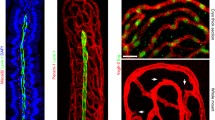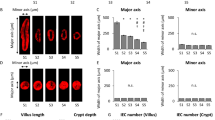Abstract
Immunofluorescence imaging enables visualization of a wide range of molecules in diverse cells and tissues. Determining the localization and endogenous protein levels in cells using immunostaining can be highly informative for researchers studying cell structure and function. The small intestinal epithelium is composed of numerous cell types including absorptive enterocytes, mucus-producing goblet cells, lysozyme positive Paneth cells, proliferative stem cells, chemosensing tuft cells, and hormone-producing enteroendocrine cells. Each cell type in the small intestine has unique functions and structures that are critical for maintaining intestinal homeostasis and identifiable by immunofluorescence labeling. In this chapter we provide a detailed protocol and representative images of immunostaining of paraffin-embedded mouse small intestinal tissue. The method highlights antibodies and micrographs that identify differentiated cell types. These details are important because quality immunofluorescence imaging can provide novel insights and a greater understanding of healthy and disease states.
Access this chapter
Tax calculation will be finalised at checkout
Purchases are for personal use only
Similar content being viewed by others
References
Barker N, van Es JH, Kuipers J, Kujala P, van den Born M, Cozijnsen M et al (2007) Identification of stem cells in small intestine and colon by marker gene Lgr5. Nature 449(7165):1003–1007. https://doi.org/10.1038/nature06196
Leblond CP, Stevens CE (1948) The constant renewal of the intestinal epithelium in the albino rat. Anat Rec 100(3):357–377. https://doi.org/10.1002/ar.1091000306
Hooper LV (2015) Epithelial cell contributions to intestinal immunity. Adv Immunol 126:129–172. https://doi.org/10.1016/bs.ai.2014.11.003
de Santa BP, van den Brink GR, Roberts DJ (2003) Development and differentiation of the intestinal epithelium. Cell Mol Life Sci 60(7):1322–1332. https://doi.org/10.1007/s00018-003-2289-3
Loo DD, Zeuthen T, Chandy G, Wright EM (1996) Cotransport of water by the Na+/glucose cotransporter. Proc Natl Acad Sci U S A 93(23):13367–13370. https://doi.org/10.1073/pnas.93.23.13367
Schultheis PJ, Clarke LL, Meneton P, Miller ML, Soleimani M, Gawenis LR et al (1998) Renal and intestinal absorptive defects in mice lacking the NHE3 Na+/H+ exchanger. Nat Genet 19(3):282–285. https://doi.org/10.1038/969
Field M (2003) Intestinal ion transport and the pathophysiology of diarrhea. J Clin Invest 111(7):931–943. https://doi.org/10.1172/JCI18326
Kato A, Romero MF (2011) Regulation of electroneutral NaCl absorption by the small intestine. Annu Rev Physiol 73:261–281. https://doi.org/10.1146/annurev-physiol-012110-142244
Engevik AC, Engevik MA (2021) Exploring the impact of intestinal ion transport on the gut microbiota. Comput Struct Biotechnol J 19:134–144. https://doi.org/10.1016/j.csbj.2020.12.008
Johansson ME, Phillipson M, Petersson J, Velcich A, Holm L, Hansson GC (2008) The inner of the two Muc2 mucin-dependent mucus layers in colon is devoid of bacteria. Proc Natl Acad Sci U S A 105(39):15064–15069. https://doi.org/10.1073/pnas.0803124105
Knoop KA, Newberry RD (2018) Goblet cells: multifaceted players in immunity at mucosal surfaces. Mucosal Immunol 11(6):1551–1557. https://doi.org/10.1038/s41385-018-0039-y
Bevins CL, Salzman NH (2011) Paneth cells, antimicrobial peptides and maintenance of intestinal homeostasis. Nat Rev Microbiol 9(5):356–368. https://doi.org/10.1038/nrmicro2546
Sato T, van Es JH, Snippert HJ, Stange DE, Vries RG, van den Born M et al (2011) Paneth cells constitute the niche for Lgr5 stem cells in intestinal crypts. Nature 469(7330):415–418. https://doi.org/10.1038/nature09637
Sternini C, Anselmi L, Rozengurt E (2008) Enteroendocrine cells: a site of ‘taste’ in gastrointestinal chemosensing. Curr Opin Endocrinol Diabetes Obes 15(1):73–78. https://doi.org/10.1097/MED.0b013e3282f43a73
Yu Y, Yang W, Li Y, Cong Y (2020) Enteroendocrine cells: sensing gut microbiota and regulating inflammatory bowel diseases. Inflamm Bowel Dis 26(1):11–20. https://doi.org/10.1093/ibd/izz217
Gribble FM, Reimann F (2016) Enteroendocrine cells: Chemosensors in the intestinal epithelium. Annu Rev Physiol 78:277–299. https://doi.org/10.1146/annurev-physiol-021115-105439
Worthington JJ, Reimann F, Gribble FM (2018) Enteroendocrine cells-sensory sentinels of the intestinal environment and orchestrators of mucosal immunity. Mucosal Immunol 11(1):3–20. https://doi.org/10.1038/mi.2017.73
Gerbe F, Brulin B, Makrini L, Legraverend C, Jay P (2009) DCAMKL-1 expression identifies tuft cells rather than stem cells in the adult mouse intestinal epithelium. Gastroenterology 137(6):2179–2180; author reply 80-1. https://doi.org/10.1053/j.gastro.2009.06.072
Gerbe F, Legraverend C, Jay P (2012) The intestinal epithelium tuft cells: specification and function. Cell Mol Life Sci 69(17):2907–2917. https://doi.org/10.1007/s00018-012-0984-7
Hofer D, Puschel B, Drenckhahn D (1996) Taste receptor-like cells in the rat gut identified by expression of alpha-gustducin. Proc Natl Acad Sci U S A 93(13):6631–6634. https://doi.org/10.1073/pnas.93.13.6631
Perez CA, Huang L, Rong M, Kozak JA, Preuss AK, Zhang H et al (2002) A transient receptor potential channel expressed in taste receptor cells. Nat Neurosci 5(11):1169–1176. https://doi.org/10.1038/nn952
Bezencon C, le Coutre J, Damak S (2007) Taste-signaling proteins are coexpressed in solitary intestinal epithelial cells. Chem Senses 32(1):41–49. https://doi.org/10.1093/chemse/bjl034
Kaske S, Krasteva G, Konig P, Kummer W, Hofmann T, Gudermann T et al (2007) TRPM5, a taste-signaling transient receptor potential ion-channel, is a ubiquitous signaling component in chemosensory cells. BMC Neurosci 8:49. https://doi.org/10.1186/1471-2202-8-49
Coons AH, Creech HJ, Jones RN (1941) Immunological properties of an antibody containing a fluorescent group. Proc Soc Exp Biol Med 47(2):200–202
Liu E, Vega S, Treiser M, Sung H, Moghe P (2011) Fluorescence imaging of cell-biomaterial interactions. In: Comprehensive biomaterials. Elsevier, Amsterdam, pp 291–303
Goding JW (1986) Immunofluorescence. In: Monoclonal antibodies: principles and practice, vol 255. Elsevier, Amsterdam
Bogen SA, Vani K, Sompuram SR (2009) Molecular mechanisms of antigen retrieval: antigen retrieval reverses steric interference caused by formalin-induced cross-links. Biotech Histochem 84(5):207–215. https://doi.org/10.3109/10520290903039078
Nagatake T, Fujita H, Minato N, Hamazaki Y (2014) Enteroendocrine cells are specifically marked by cell surface expression of claudin-4 in mouse small intestine. PLoS One 9(6):e90638. https://doi.org/10.1371/journal.pone.0090638
Huh WJ, Roland JT, Asai M, Kaji I (2020) Distribution of duodenal tuft cells is altered in pediatric patients with acute and chronic enteropathy. Biomed Res 41(2):113–118. https://doi.org/10.2220/biomedres.41.113
Author information
Authors and Affiliations
Corresponding author
Editor information
Editors and Affiliations
Rights and permissions
Copyright information
© 2023 The Author(s), under exclusive license to Springer Science+Business Media, LLC, part of Springer Nature
About this protocol
Cite this protocol
Digrazia, J.R., Engevik, M.A., Engevik, A.C. (2023). Identification of Differentiated Intestinal Epithelial Cells Using Immunostaining and Fluorescence Microscopy. In: Ordóñez-Morán, P. (eds) Intestinal Differentiated Cells. Methods in Molecular Biology, vol 2650. Humana, New York, NY. https://doi.org/10.1007/978-1-0716-3076-1_2
Download citation
DOI: https://doi.org/10.1007/978-1-0716-3076-1_2
Published:
Publisher Name: Humana, New York, NY
Print ISBN: 978-1-0716-3075-4
Online ISBN: 978-1-0716-3076-1
eBook Packages: Springer Protocols




